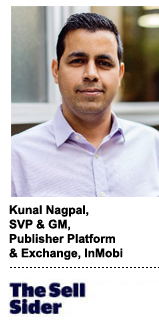“The Sell Sider” is a column written by the sell side of the digital media community.
Today’s column is written by Kunal Nagpal, SVP and GM, publisher platform and exchange, at InMobi.
The middle of the mediation market is disappearing quickly, leaving mobile app developers with tough decisions to make.
Mediation requires technological expertise, scale, and business resources to bring demand diversity and liquidity to the sell side. But these deliverables are only available to developers that are sophisticated and large enough to influence both buyers and platforms.
Still, there’s a discrete set of choices on the spectrum of mediation offerings. On one end is the self-owned in-house solution. On the other, there’s a fully controlled third-party mediation platform – an option in theory only. Somewhere between these two extremes is a third-party platform sitting within a large media business that, up until now, has been the most practical option for most developers.
But this middle ground is undergoing rapid consolidation into a handful of big platforms. Overnight, the space has gone from a few reasonably independent, large-scale mediation platforms to a consolidated field that lacks any real independent options. In fact, many of these platforms are at odds with developers’ best interests. Control, neutrality, and transparency – the most important aspects for publishers – are being ceded without recourse.
What does this all mean for mobile app developers?
Unfortunately, all this consolidation is even worse than it looks.
Conflict of interest
Several leading mediation platforms today have their own gaming studios. They are competing with independent gaming developers. Developers are right to fear possible data leakage in favor of mediation’s gaming studios’ interests. Some platforms also run their own exchanges/marketplaces, which means there’s absolutely no way to know (through audit or other mechanisms) if their exchanges bias media flow toward their in-house and operated apps.
Lack of data and revenue audit
Most exchanges operate on a revenue share model that varies from 5% to 50%. The range reveals the preferential treatment toward certain developers. Mediation platforms also charge the demand side, especially when they use header bidding. But there’s no opportunity for developers to easily access data on these financial dealings. On top of that, accurate data is either unavailable or difficult to get. This makes it challenging for developers to analyze the aspects of auctions that are useful for core needs, like user experience and user acquisition.
Lack of control
The mediation platform establishes rules that control the mechanisms for distributing inventory. There’s limited opportunity for developers to exert influence or make changes to those rules. That’s especially challenging, given the pace necessary to fully extract value from the ad transaction. As platforms grow, their power increases exponentially.
Skewed demand portfolio
Outside of Google, no other mediation stack offers the breadth of connections developers need for every auction to maximize user base value. This won’t change because demand diversity and liquidity are not the primary goals of the marketplaces that own mediation platforms.
So, what are developers doing to respond to this shift in the ecosystem?
The largest developers have already started taking mediation in-house to gain a level of control and transparency that comes only from a direct relationship with the buy side. Consolidation accelerates this trend.
Developers that lack the resources to build an in-house stack but are large enough to exert meaningful influence on the mediation platforms are striking deals with a renewed focus on transparency and control over the buy-side data and economics.
Smaller developers, accounting for much of the industry, can only protect themselves by aggregating their bargaining power to demand greater neutrality, control and transparency from mediation platforms. This aggregation is neither easy nor natural and is currently limited to a few small pockets of the industry.
What’s next for the mediation market?
It’s time for app developers to dig deep and answer key questions: Are you looking for the value of in-house while removing the time, effort and money associated with building it? Do you need to link ad monetization with IAP, UX and UA?
All of these are achievable, but publishers have to consider what data valuation looks like for them, and find a partner to fully support their vision.
Follow InMobi (@inMobi) and AdExchanger (@adexchanger) on Twitter.














